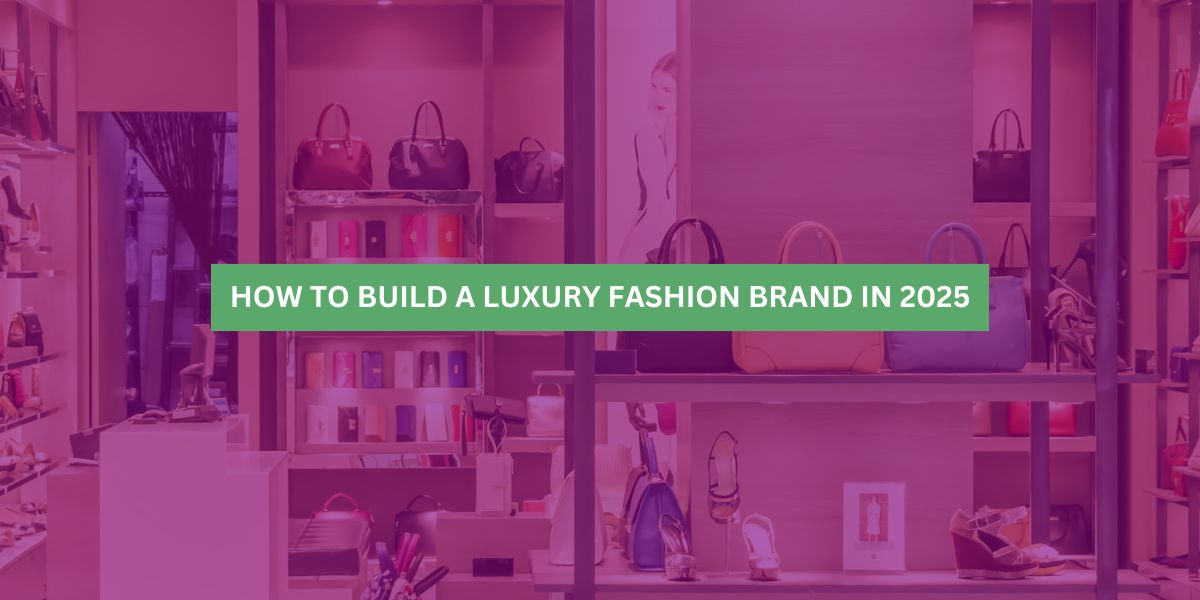As we approach 2025, the rules of building a luxury fashion brand are shifting. The rise of digital transformation, sustainability concerns, and changing consumer behaviors are reshaping the way luxury brands are conceived, developed, and marketed. If you’re an aspiring entrepreneur or designer looking to build a luxury fashion brand in 2025, this guide will provide you with actionable insights and strategies to succeed in this competitive space.
1. Define Your Brand Identity and Vision
The foundation of any successful luxury fashion brand is a clear and compelling brand identity. Luxury is not just about high prices; it’s about storytelling, heritage, and emotional connection. To stand out in 2025, your brand must have a unique point of view and a vision that resonates with your target audience.
- Craft a compelling narrative: Luxury consumers buy into stories, not just products. What is the story behind your brand? Is it rooted in craftsmanship, innovation, or cultural heritage? For example, brands like Chanel and Gucci have built their identities around timeless elegance and bold creativity, respectively.
- Define your core values: In 2025, consumers will increasingly align themselves with brands that share their values. Whether it’s sustainability, inclusivity, or innovation, your brand’s values should be authentic and consistently communicated.
- Create a distinct aesthetic: Luxury fashion is as much about visual identity as it is about quality. Develop a signature style that sets your brand apart, whether it’s through unique silhouettes, bold patterns, or innovative materials.
2. Embrace Sustainability and Ethical Practices
Sustainability is no longer a trend; it’s a necessity. By 2025, consumers will demand even greater transparency and accountability from luxury brands. Building a sustainable luxury fashion brand is not just good for the planet—it’s also a smart business strategy.
- Source responsibly: Use eco-friendly materials such as organic cotton, recycled fabrics, and innovative alternatives like mushroom leather or lab-grown diamonds. Partner with suppliers who adhere to ethical labor practices.
- Adopt circular fashion principles: Encourage customers to return used items for recycling or upcycling. Offer repair services to extend the lifespan of your products.
- Be transparent: Share your sustainability journey with your audience. Use blockchain technology to provide traceability and prove the authenticity of your materials and processes.
- Educate your consumers: Luxury consumers are willing to pay a premium for sustainable products, but they need to understand the value. Use storytelling to highlight the positive impact of their purchase.
3. Leverage Technology and Innovation
Technology is revolutionizing the luxury fashion industry, from design and production to marketing and retail. To build a successful luxury brand in 2025, you must embrace innovation and stay ahead of the curve.
- Invest in digital design tools: Use 3D design software and virtual prototyping to streamline the design process and reduce waste. This allows you to experiment with new ideas without the cost and environmental impact of physical samples.
- Explore AI and data analytics: Use artificial intelligence to analyze consumer behavior, predict trends, and personalize the shopping experience. AI can also help you optimize inventory management and reduce overproduction.
- Adopt augmented reality (AR) and virtual reality (VR): Enhance the customer experience by offering virtual try-ons, immersive runway shows, and virtual showrooms. These technologies allow customers to engage with your brand in innovative ways.
- Experiment with Web3 and NFTs: The metaverse and blockchain technology are opening up new opportunities for luxury brands. Consider creating digital fashion items, virtual collections, or NFTs that offer exclusive benefits to your customers.
4. Build a Strong Digital Presence
In 2025, a strong digital presence will be essential for any luxury fashion brand. While traditional luxury brands have historically relied on exclusivity and physical retail, the future of luxury is increasingly digital.
- Create a seamless e-commerce experience: Your website should reflect the luxury experience, with high-quality visuals, intuitive navigation, and personalized recommendations. Offer services like virtual styling consultations or made-to-order options to enhance the online shopping experience.
- Leverage social media: Platforms like Instagram, TikTok, and Pinterest are powerful tools for building brand awareness and engaging with your audience. Use these platforms to showcase your brand’s story, behind-the-scenes content, and user-generated content.
- Collaborate with influencers: Partner with influencers and brand ambassadors who align with your values and aesthetic. Micro-influencers, in particular, can help you reach niche audiences and build authenticity.
- Explore live shopping: Live streaming is becoming increasingly popular in the luxury space. Host live shopping events where customers can interact with your team, ask questions, and make purchases in real-time.
5. Focus on Exclusivity and Personalization
Exclusivity and personalization are at the heart of luxury. In 2025, consumers will expect even more tailored experiences and unique offerings.
- Offer limited-edition collections: Create a sense of urgency and exclusivity by releasing limited-edition pieces or capsule collections. This not only drives demand but also reinforces your brand’s premium positioning.
- Provide bespoke services: Allow customers to customize their purchases, whether it’s through monogramming, custom fittings, or made-to-order designs. Personalization adds value and creates a deeper emotional connection with your brand.
- Build a membership program: Offer exclusive benefits to loyal customers, such as early access to new collections, private events, or personalized styling services. This fosters a sense of community and loyalty.
6. Prioritize Inclusivity and Diversity
The luxury fashion industry has historically been criticized for its lack of diversity and inclusivity. In 2025, brands that embrace inclusivity will have a competitive edge.
- Represent diverse voices: Ensure your marketing campaigns, runway shows, and product offerings reflect a wide range of cultures, body types, and identities. Collaborate with diverse designers, models, and creatives.
- Expand sizing options: Offer a wider range of sizes to cater to all customers. Inclusivity is not just a moral imperative; it’s also a business opportunity.
- Celebrate cultural heritage: Draw inspiration from different cultures in a respectful and authentic way. Celebrate diversity through your designs, storytelling, and collaborations.
7. Master the Art of Storytelling
Storytelling is a powerful tool for building emotional connections with your audience. In 2025, luxury brands will need to go beyond traditional advertising and create immersive, multi-sensory experiences.
- Use content marketing: Share your brand’s story through blogs, videos, podcasts, and social media. Highlight the craftsmanship, inspiration, and people behind your products.
- Host experiential events: Create memorable experiences that bring your brand to life, such as pop-up shops, art installations, or immersive runway shows. These events not only generate buzz but also deepen customer loyalty.
- Collaborate with other creatives: Partner with artists, musicians, and filmmakers to create unique content and experiences. Collaborations can help you reach new audiences and add depth to your brand’s narrative.
8. Build a Community Around Your Brand
Luxury is no longer just about the product; it’s about the community and lifestyle that surrounds it. In 2025, successful luxury brands will foster a sense of belonging among their customers.
- Engage with your audience: Respond to comments, messages, and reviews. Show your customers that their opinions matter.
- Create user-generated content: Encourage your customers to share their experiences with your brand on social media. Repost their content to build a sense of community and authenticity.
- Host exclusive events: Invite your most loyal customers to private events, such as fashion shows, product launches, or workshops. These experiences create a sense of exclusivity and strengthen customer relationships.
9. Balance Tradition and Innovation
One of the hallmarks of luxury is its connection to tradition and heritage. However, to succeed in 2025, you must also embrace innovation and modernity.
- Honor craftsmanship: Highlight the artistry and skill that goes into creating your products. Whether it’s hand-stitched details or traditional techniques, craftsmanship is a key differentiator for luxury brands.
- Embrace innovation: While tradition is important, don’t be afraid to experiment with new materials, technologies, and business models. The most successful luxury brands are those that strike a balance between heritage and innovation.
10. Stay Agile and Adapt to Change
The fashion industry is notoriously fast-paced, and the luxury sector is no exception. To build a successful luxury brand in 2025, you must be agile and willing to adapt to changing trends and consumer preferences.
- Monitor industry trends: Stay informed about emerging trends in fashion, technology, and consumer behavior. Attend industry events, read trade publications, and network with other professionals.
- Listen to your customers: Use feedback and data to refine your products, services, and marketing strategies. Your customers are your best source of insight.
- Be willing to pivot: If something isn’t working, don’t be afraid to change course. The ability to adapt is crucial in a rapidly evolving industry.
Conclusion
Building a luxury fashion brand in 2025 is both an exciting and challenging endeavor. By defining a clear brand identity, embracing sustainability, leveraging technology, and prioritizing inclusivity, you can create a brand that resonates with modern consumers. Remember, luxury is not just about the product—it’s about the experience, the story, and the emotional connection you create with your audience. With the right strategies and a commitment to innovation, you can build a luxury fashion brand that stands the test of time.








